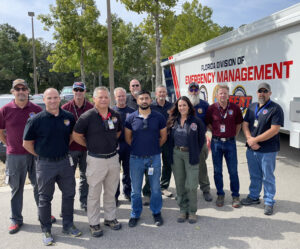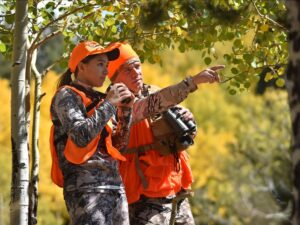
Waterfowl production in Colorado during 2022 was likely variable and ranged from poor to average depending on local water and weather conditions. However, most ducks and geese in Colorado during the fall and winter hunting seasons are migrants arriving from states to the north and Canada. Each year the U.S. Fish and Wildlife Service conducts surveys of waterfowl and their habitats in these primary breeding areas. These surveys were suspended during 2020 and 2021 due to the COVID-19 pandemic, but surveys were completed in 2022.
The total pond estimate (breeding habitat calculation) in Prairie Canada and the northcentral U.S. was 5.5 million, 9% above the 2019 estimate and similar to the long-term average. In areas that produce many of the ducks that migrate to and through Colorado, conditions were dry: in southern Alberta, 2022 pond numbers were 25% below 2019 numbers and 9% below the long-term average, and in Montana and the western Dakotas, 2022 pond numbers were 50% below 2019 numbers and 7% below the long-term average. These areas were judged by survey biologists to have mostly fair or poor habitat conditions.
In 2022, the total duck breeding population estimate in the surveyed area was 34.2 million birds, 12% lower than the 2019 estimate of 41.2 million and 4% below the long-term average (1955 – 2019). In southern Alberta, 2022 breeding duck numbers were 35% below 2019 numbers and 32% below the long-term average, and in Montana and the western Dakotas, 2022 breeding duck numbers were 29% below 2019 numbers and 2% below the long-term average. Total breeding population estimates of the five most harvested ducks in Colorado showed mixed patterns:
Mallard
Estimated mallard abundance was 7.2 million, 23% below the 2019 estimate of 9.4 million and 9% below the long-term average of 7.9 million.
Green-winged teal
The estimated abundance of green-winged teal was 2.2 million, 32% below the 2019 estimate of 3.2 million and similar to the long-term average.
Gadwall
Estimated abundance of gadwall was 2.7 million, 18% below the 2019 estimate but 30 percent above the long-term average.
Blue-winged teal
The 2022 estimate for blue-winged teal was 6.5 million, 9% above the 2019 estimate and 27% above the long-term average of 5.1 million.
American wigeon
Abundance estimates for American wigeon was 2.1 million, 25% below the 2019 estimate and 19% below the long-term averages of 2.6 million.
Canada goose production in Colorado appeared to be fair to good, and variable habitat conditions across the region likely resulted in average breeding success for Canada geese that winter in Colorado. For Arctic-nesting cackling geese and snow and Ross’s geese that occur in Colorado, average and variable spring thaw conditions likely resulted in average production. Populations of Canada and Arctic-nesting geese remain at relatively high numbers.
Colorado’s waterfowl environments are diverse, ranging from shallow wetlands to large reservoirs. With continuing drought, many reservoirs and wetlands are drier than normal as we enter the hunting seasons. Early migrant ducks such as teal, gadwall, shovelers, and wigeon usually move through Colorado in October and November on their way to more southern wintering areas, but with dry conditions these species may migrate quickly and spend relatively little time in Colorado. For later migrants, particularly mallards and Canada geese, typically the best hunting is available when a winter cold front pushes birds south from southern Canada, the Dakotas, Montana and Wyoming.
Colorado’s waterfowl season dates and bag limits for 2022-2023 are similar to 2021-2022. In the Pacific Flyway portion of the state, the daily bag limit for Canada geese has increased from four to five. In the central Flyway portion of the state, there is no longer a separate bag limit for mergansers; they are now included in the overall duck daily bag limit.
As always, we suggest hunters get out to scout areas ahead of time for a successful season. Local conditions and the timing of migration are always changing. Take a look around areas where you want to hunt and check local conditions. Even if you always hunt the same area, water, habitat, and patterns of bird use can change every year. Doing some scouting can help you plan your hunt and you may find new areas.
In winter 2021-2022, waterfowl and other wild birds had widespread infections with new strains of highly pathogenic avian influenza (HPAI). We expect that infected waterfowl will be present in Colorado during the 2022-2023 waterfowl seasons.
- Do not handle or eat sick game.
- Field dress and prepare game outdoors or in a well-ventilated area.
- Wear rubber or disposable nitrile gloves while handling and cleaning game.
- When done handling game, wash hands thoroughly with soap or disinfectant, and clean knives, equipment, and surfaces that came in contact with game.
- Do not eat, drink, or smoke while handling animals.
- All game should be thoroughly cooked to an internal temperature of 165 F before being consumed.
Colorado Outdoors Online, in cooperation with Ducks Unlimited, offers a Waterfowl Resource Guide to help hunters get the most out of their time in the field.
For most waterfowl hunters, finding a place to hunt is often more challenging than the hunt itself. Fortunately, Colorado offers a variety of public land hunting opportunities. Here is some information and tips on hunting waterfowl on public land.










